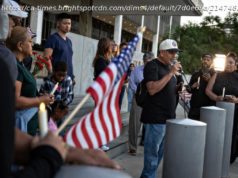Justice O’Connor, 88, was the first woman to serve on the Supreme Court. She wielded immense power and often found ways to bridge divides in a less polarized era.
WASHINGTON — The first woman to serve on the Supreme Court was just 75, young by its standards, and still sharp and vigorous. But she gave up a job she loved, along with extraordinary power, to guide and comfort her husband, who was struggling with Alzheimer’s disease.
Justice Sandra Day O’Connor handled her new role with grit and good humor, even when her husband had a romance with another woman in the assisted-living center where he spent his days. She would visit the new couple while they held hands on a porch swing, beaming with relief to see her husband of 55 years at peace. He died in 2009, three years after her retirement.
On Tuesday, Justice O’Connor announced her own reckoning with the disease that had afflicted her husband, John J. O’Connor III.
“Some time ago,” she wrote in a characteristically blunt and candid public letter, “doctors diagnosed me with the beginning stages of dementia, probably Alzheimer’s disease. As this condition has progressed, I am no longer able to participate in public life.”
As Justice O’Connor, 88, exits the public stage, so does the kind of figure once familiar in American political and judicial circles: a moderate Republican ready to find compromise and common ground. In her letter, she called for a renewed commitment to nonpartisan values, one that requires “putting country and the common good above party and self-interest, and holding our key governmental institutions accountable.”
Justice O’Connor’s announcement was also a poignant reminder of dementia’s toll as Americans are living longer than ever.
“Since many people have asked about my current status and activities,” Justice O’Connor wrote, “I want to be open about these changes, and while I am still able, share some personal thoughts.”
RonNell Andersen Jones, who served as a law clerk to Justice O’Connor and teaches law at the University of Utah, said the letter was of a piece with the justice’s attitude toward life’s challenges.
“She’s handling this just as she handled her husband John’s diagnosis, and just as she’s handled everything she’s faced in life — with grace, determination and dignity,” Professor Jones said.
Appointed to the court in 1981 by President Ronald Reagan, Justice O’Connor drew on a breadth of experience largely missing among the current justices. Raised and educated in the West, she served in all three branches of Arizona’s government, including as a government lawyer, majority leader of the State Senate, elected trial judge and appeals court judge.
Her background informed her jurisprudence, which was sensitive to states’ rights and often deferred to the judgments of the other branches of the federal government. Her rulings were often pragmatic and narrow, and her critics said she engaged in split-the-difference jurisprudence.
But some of her commitments were unyielding, said Justice Ruth Bader Ginsburg, the second woman to serve on the Supreme Court. “As often as Justice O’Connor and I have disagreed, because she is truly a Republican from Arizona, we were together in all the gender discrimination cases,” Justice Ginsburg told USA Today in 2009.
Justice O’Connor joined the controlling opinion in Planned Parenthood v. Casey, the 1992 decision that, to the surprise of many, reaffirmed the core of the constitutional right to abortion established in 1973 in Roe v. Wade. To overrule Roe “under fire in the absence of the most compelling reason to re-examine a watershed decision,” she wrote in a joint opinion with Justices Anthony M. Kennedy and David H. Souter, “would subvert the court’s legitimacy beyond any serious question.”
Cristina Rodríguez, who served as a law clerk to Justice O’Connor and now teaches at Yale Law School, said the justice’s contributions were not limited to her opinions.
“The justice shaped numerous areas of the law in her time, including by challenging sex discrimination and antiquated assumptions about gender roles and women’s agency, by defining a robust place for states in our constitutional structure, by defending as compelling the pursuit of diversity in our universities,” Professor Rodríguez said. “But more than any set of precedents, which may or may not be enduring, she exercised practical wisdom, understanding that the court’s decisions had effects in the world and that the justices bore some responsibility for whatever they wrought.”
Professor Jones said Justice O’Connor had faced enormous challenges.
“It wasn’t easy to be the first ‘Sister’ among the ‘Brethren,’ but she modeled perfect civility and taught us that public service in a democracy is a noble calling that demands the very best of a person,” Professor Jones said, adding that Justice O’Connor had a deep commitment to civility and always urged students to “learn to disagree agreeably.”
“That advice,” Professor Jones said, “feels all the more important today.”
For years after her retirement from the Supreme Court, Justice O’Connor kept a busy schedule, hearing cases on appeals courts, lecturing and promoting civics education. But she has not been seen in public for some time, prompting vague reports of failing health.
Tuesday’s letter clarified matters. It also gave Justice O’Connor one more opportunity to encourage young people to learn about civics. Here, too, the subtext was a yearning for an era in which compromise and collaboration were possible.
“I can no longer help lead this cause, due to my physical condition,” she wrote. “It is time for new leaders to make civic learning and civic engagement a reality for all.”
Chief Justice John G. Roberts Jr. applauded that effort. “I was saddened to learn that Justice Sandra Day O’Connor, like many Americans, faces the challenge of dementia,” he said in a statement . “But I was not at all surprised that she used the occasion of sharing that fact to think of our country first, and to urge an increased commitment to civics education, a cause to which she devoted so much of her time and indomitable energy.”
The chief justice also sketched out his former colleague’s place in history. “She broke down barriers for women in the legal profession to the betterment of that profession and the country as a whole,” he wrote. “She serves as a role model not only for girls and women, but for all those committed to equal justice under law. Although she has announced that she is withdrawing from public life, no illness or condition can take away the inspiration she provides for those who will follow the many paths she has blazed.”
Justice O’Connor was more than a trailblazer and role model on the Supreme Court. Since she held the crucial vote in many of its most highly charged cases, her vision shaped American life for her quarter century on the court. Political scientists marveled at the power she wielded.
Домой
United States
USA — mix Battling Dementia, Sandra Day O’Connor Leaves Public Life With Plea for Bipartisanship






